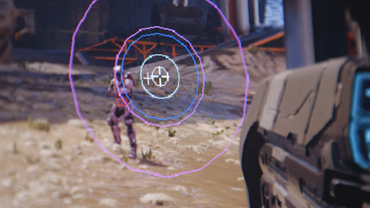
Aim assist, also known as auto-aim and bullet magnetism, refers to a system in place in the Halo video games designed to make targeting enemy combatants easier for players. Aim assist subtly modifies the trajectory of shots that the player fires, to direct them towards the enemy they are firing upon, if that enemy is close enough to the player's reticle. When the reticle is red, it indicates that aim assist is fully engaged and the shots will be directed straight towards the enemy. However, aim assist is often still active when the reticle is not red, steering the shots closer to the enemy - just not directly at them.[1]
The radius around the reticle at which aim assist takes effect varies significantly depending on the weapon, with some weapons having significantly stronger aim assist than others. Another factor that affects aim assist strength is whether the player is zoomed in or hip firing - when zoomed, the angle at which aim assist is applied becomes smaller, to account for the finer camera control the user has at that magnification level. Finally, the distance of the enemy from the player also impacts the strength of the aim assist - beyond a certain distance, aim assist will not kick in at all and the reticle will not turn red, leading to the notion of red reticle range. At these distances, the weapon becomes far less effective.
Although useful, aim assist does not guarantee that the shot will hit the targeted enemy, for multiple reasons. If the weapon's projectiles are slow-moving, the enemy may have time to anticipate the shot and dodge it. Additionally, weapon spead is applied after aim assist, so weapons with significant random spread or bloom may still miss a stationary target even when the reticle is red, if the spread happens to divert the shot away from the enemy.
Gallery
A debug view in Halo 5: Guardians, where aim assist is partially engaged. The smaller white cross shows where the shot will be directed.
